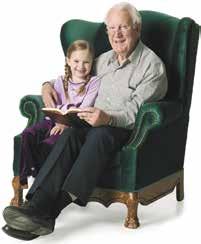
3 minute read
Holbrook Indian School

Loren Fish Laura Sohn

MAPS: Mental Health at Holbrook Indian School
You might have heard of or read about an acronym that we like to use at Holbrook Indian School: MAPS. If you haven’t, then allow us to introduce it to you. This program seeks to improve every dimension in our students’ lives to help make their futures brighter.
The program has four pillars: Mental, Academic/Artistic, Physical, and Spiritual. Each pillar is a fundamental component of the students’ environment and education, with specific and practical applications. This article begins a series where we will focus on each pillar, starting with the “M” (mental health).
Our students often have troubling circumstances in their lives that can limit their ability to learn. Overcoming the mental roadblocks that these experiences and behavioral patterns create can be a big challenge. Part of our solution is to provide our students with individualized counseling services. This is where licensed counselors play a key role in assisting students in expressing their stories and assessing how to change negative behaviors and thought patterns.
Licensed counselors Laura Sohn and Loren Fish, who make up a two-person team of counselors at HIS, will help us review this topic in this month’s issue by sharing some of what their work entails.
Laura Sohn
I’m entering my second semester here at Holbrook Indian School (HIS), and my role here is the female clinical counselor. I meet with students one-on-one in the office from Monday to Friday. In addition to these one-on-one meetings, I’m also responsible for the girls’ groups that meet once a week. We base these groups on grade levels. In total, I have four girls’ groups: one for junior high, one for high school, and two for elementary. The purpose of the girls’ groups is to give the students an opportunity to hang out, eat some snacks, relax, and talk about whatever is on their minds.
These are not always therapy-type group sessions. Sometimes we just play games. For the older students, I ask them at the beginning of the semester about topics they are interested in talking about, and they all choose something we end up exploring together.
To watch the complete two-part discussion Mental Health at HIS, visit the HIS Nation blog at HolbrookIndianSchool.org/hisnation/mental.

Loren Fish
I’m a licensed clinical social worker and director of the counseling department at HIS. In addition to group meetings with the boys, I work with the students, male and female, doing individual counseling.
In the young men’s group, we try to keep our sessions fairly relaxed. I try to check in for each meeting to ask them about their high and low for the week.
I also ask them to share a color to represent where their current emotions are, using a color chart related to a series of emotions. Sometimes a student shares more than one, and I ask if they want to talk about what those different colors mean. Boys tend to not talk as freely or fluently about emotions as girls, but I find it encouraging when these young men express their emotions. We feel very blessed to be able to have a counseling program at HIS—to be able to address some issues like PTSD, abuse, and generational trauma. With our counseling program, we are able to help students focus on what they're here for, which is to learn and grow.

____________________ By Chevon Petgrave, Loren Fish, and Laura Sohn
Holbrook Indian School (HIS) is a first- through twelfth-grade boarding academy operated by the Pacific Union Conference of the Seventhday Adventist Church. HIS also manages a first- through eighth-grade day school on the Navajo reservation in Chinle, Arizona. Eighty percent of funding comes from individuals who have a desire to support Native American ministries and Christian education. Your generosity makes a difference in the lives of our students, their families, and the communities they serve.
Thank you for your support.
DEVELOPMENT DEPARTMENT
P.O. Box 910 I Holbrook, Arizona 86025-0910 I (928) 524-6845 (Ext. 109) I Development@hissda.org I HolbrookIndianSchool.org










